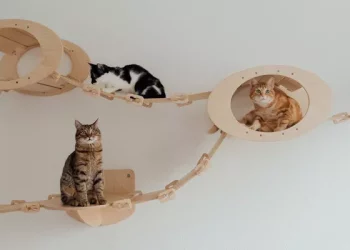Corn snakes are a popular choice among reptile enthusiasts, especially for beginner snake keepers. These docile and easy-to-care-for snakes originate from the southeastern United States and are known for their vibrant colors and manageable size. Setting up the right habitat is crucial for their health, comfort, and overall quality of life. A well-designed environment not only ensures that your corn snake thrives, but it also makes caring for them easier. This guide will walk you through everything you need to create a suitable habitat for your corn snake, from enclosure size and substrate to temperature and humidity.
1. Choosing the Right Enclosure
The first step in setting up a corn snake habitat is selecting the appropriate enclosure. There are several options available, each with its advantages and disadvantages. Here are some of the most common types:
Glass Tanks
Glass tanks are a popular choice for corn snakes. They provide excellent visibility, allowing you to watch your snake at all times, and they’re widely available in pet stores.
Pros: Easy to clean, widely available, good visibility.
Cons: Can be heavy and hard to move, challenging to maintain humidity levels in certain environments.
PVC Enclosures
PVC enclosures are lightweight, durable, and generally better at maintaining stable temperatures and humidity than glass tanks.
Pros: Lightweight, good temperature and humidity control, easy to clean.
Cons: More expensive than glass tanks, not as widely available.
Plastic Storage Tubs
Plastic storage tubs are an affordable alternative, commonly used by snake breeders and keepers with multiple snakes. They are lightweight, easy to clean, and excellent at retaining heat and humidity.
Pros: Affordable, good heat and humidity retention, lightweight.
Cons: Limited visibility, not as aesthetically pleasing.
Size Guidelines
A general rule for adult corn snakes is that the enclosure should be at least as long as the snake’s body length. Here’s a rough guideline:
Baby Corn Snake (up to 12 inches): 10-gallon tank or equivalent
Juvenile Corn Snake (12-36 inches): 20-gallon tank or equivalent
Adult Corn Snake (36-60 inches): 30-40-gallon tank or equivalent
2. Substrate Selection
Substrate refers to the bedding or floor material in the enclosure. Choosing the right substrate can make a significant difference in your corn snake’s comfort and health.
Aspen Shavings
Aspen is one of the most commonly used substrates for corn snakes. It’s soft, absorbent, and allows for burrowing, which corn snakes enjoy.
Pros: Good for burrowing, absorbent, inexpensive.
Cons: Can get dusty, needs regular spot cleaning.
Coconut Husk
Coconut husk is a natural and eco-friendly option that helps retain humidity.
Pros: Holds humidity, safe for snakes, natural appearance.
Cons: More expensive than aspen, needs occasional misting to prevent drying out.
Newspaper or Paper Towels
Newspaper and paper towels are often used by breeders because they are easy to clean and inexpensive.
Pros: Inexpensive, easy to clean, reduces the risk of mite infestations.
Cons: Doesn’t provide burrowing opportunities, less attractive in appearance.
Reptile Carpet
Reptile carpet is a washable, reusable substrate that looks clean and polished.
Pros: Reusable, easy to clean, no ingestion risk.
Cons: Doesn’t allow burrowing, can harbor bacteria if not regularly cleaned.
3. Temperature and Heating Requirements
Corn snakes are ectothermic, which means they rely on their environment to regulate their body temperature. In captivity, providing a temperature gradient is essential for your corn snake’s health.
Temperature Gradient
A temperature gradient allows the snake to move to different areas of the enclosure to regulate its body temperature.
Hot Side: 85-90°F (29-32°C)
Cool Side: 70-75°F (21-24°C)
Heating Options
Under-Tank Heater (UTH): An under-tank heater is one of the most common heating methods for corn snakes. It is placed under one side of the tank, creating a warm spot for your snake.
Ceramic Heat Emitter (CHE): A ceramic heat emitter provides heat without light, which is ideal for maintaining nighttime temperatures.
Heat Lamps: Although heat lamps can be used, they often dry out the air, making it harder to maintain proper humidity levels. They can also disturb your snake’s natural day-night cycle if left on for extended periods.
Heat Tape: Heat tape is often used in plastic storage tubs or rack systems. It’s affordable, efficient, and excellent for maintaining temperatures in multiple enclosures.
Thermostat and Thermometer
Using a thermostat is essential when setting up a heating source to prevent overheating. Place digital thermometers on both the warm and cool sides of the enclosure to monitor the temperature accurately.
4. Lighting Requirements
Corn snakes are crepuscular, meaning they are most active at dawn and dusk. They don’t require UVB lighting, as they get all their vitamin D from their diet. However, a simple day-night cycle with ambient room light or a low-wattage light source can help maintain their circadian rhythm.
Daylight Hours: 10-12 hours of light each day.
Nighttime: No light is needed, as corn snakes are adapted to low-light environments.
Using a low-wattage LED bulb on a timer can help you maintain a consistent light cycle. Avoid using bright lights, as these can be stressful for your corn snake.
5. Humidity Levels
Corn snakes thrive in moderate humidity levels, around 40-50%. Here are some tips for maintaining proper humidity:
Mist Occasionally: Light misting with water can help increase humidity levels temporarily, especially during shedding.
Water Dish: Provide a water dish large enough for your snake to soak in if desired, as this can help with hydration and humidity.
Monitor Humidity: Use a digital hygrometer to monitor humidity levels and ensure they stay within the desired range.
6. Hides and Climbing Structures
Corn snakes are natural burrowers and enjoy hiding, so providing multiple hiding spots is essential.
Hiding Spots
Corn snakes need at least two hides: one on the warm side and one on the cool side. Hides give your snake a place to feel safe and secure, which is crucial for reducing stress. Choose hides that are snug-fitting to give your snake a sense of security.
Climbing Branches and Enrichment
Corn snakes are semi-arboreal, meaning they will occasionally climb if given the opportunity. Including branches, logs, or artificial plants can provide mental and physical enrichment, allowing your snake to exercise and explore.
7. Water Dish and Humidity Maintenance
A water dish is essential for any corn snake habitat. The dish should be large enough for your snake to soak in, as they may occasionally do so, especially during shedding.
a. Positioning the Water Dish
Place the water dish on the cool side of the enclosure to prevent the water from evaporating too quickly. In dryer climates, you may need to mist the enclosure lightly to maintain humidity levels.
b. Cleaning the Water Dish
Change the water daily, as snakes can sometimes defecate in the dish. Clean it weekly with a reptile-safe disinfectant to prevent bacterial growth.
8. Enclosure Maintenance and Cleaning
Maintaining a clean enclosure is essential for your snake’s health. Here’s a recommended cleaning schedule:
Daily: Spot clean to remove any waste or shed skin.
Weekly: Clean the water dish and replace the water.
Monthly: Perform a deep clean of the enclosure, including removing and disinfecting all décor and substrate.
Use a reptile-safe cleaner to avoid exposing your snake to harmful chemicals. When cleaning, check for any potential hazards in the enclosure, such as loose wires or sharp edges.
9. Common Health Concerns for Corn Snakes in Captivity
Maintaining the right habitat reduces the risk of many common health issues in corn snakes. However, here are a few conditions to watch for:
Respiratory Infections: Caused by poor ventilation or incorrect temperature/humidity.
Mites: Tiny parasites that can infest your snake and enclosure. Check regularly for small black or red spots.
Shedding Problems: Often caused by low humidity. If your snake has difficulty shedding, increase humidity and provide a damp hide.
10. Safety and Enclosure Security
Corn snakes are known for their ability to escape, so make sure your enclosure is secure. Use a tight-fitting lid with locks or clips, especially if using a glass tank. Regularly check for any gaps or weaknesses in the enclosure to ensure your snake remains safely contained.
11. Setting Up the Enclosure Step-by-Step
To summarize the essentials, here’s a step-by-step guide to setting up your corn snake habitat:
Choose the Right Enclosure: Glass tank, PVC enclosure, or storage tub.
Add Substrate: Place 1-2 inches of suitable substrate like aspen or coconut husk.
Install Heating: Set up a UTH, heat emitter, or heat lamp with a thermostat.
Create a Temperature Gradient: Ensure there’s a warm side (85-90°F) and cool side (70-75°F).
Monitor Humidity: Aim for 40-50% humidity and provide a water dish.
Provide Hides and Enrichment: Add at least two hides and optional climbing structures.
Install Lighting: Provide a 10-12 hour day/night cycle with indirect light.
Regular Maintenance: Clean regularly, monitor health, and adjust as needed.
Conclusion
Setting up a suitable corn snake habitat is a rewarding experience that ensures your pet remains healthy and comfortable. By considering factors such as enclosure size, temperature, humidity, and enrichment, you can create a thriving environment for your corn snake to grow and flourish. With the right care, your corn snake will be a fascinating, low-maintenance pet that can live for many years to come.
Related Topics:
























